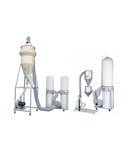Dust Removal and Collection
There are two sources of plastic dust, one is produced by crushing, and the other is produced during production process.
There are many ways to crush and pulverize materials, and the following types will generate dust.
- Squeeze and crushing:
The material is placed in two rollers or mechanism. By adjusting the distance between the two, gradually pressurizing to make it elastically deform, plastically deform to rupture and crush. This crushing is suitable for brittle materials. - Bending and crushing:
The material bears the bending hard force in the two machine parts, and breaks due to exceeding the strength limit. This method is used to process larger and longer materials. - Shearing and crushing:
The material is put into a crushing chamber with a rotary cutter and sheared with a fixed knife. This method is used to treat workshop waste or waste in the production process. - Shattering and crushing:
The material is broken in the crushing chamber where the material is running at a relatively high speed, and it can be crushed from large pieces to finely crushed into powder. Generally, fine crushing is the main method.
The powder produced by the crushing can be selected by a vibrating screen. A high-frequency vibrating motor is used to make the material on the inclined screen surface jump and produce a powder removal effect. There are many types of vibrating screens, including linear vibrating screens, horizontal vibrating screens, shaking screen, eccentric screen, rotary vibrating screen, circular vibrating screen, banana vibrating screen, probability screen... etc. can be selected.
These plastic dusts have three major effects:
- It is very harmful to the human body. Inhalation into the lungs through the respiratory tract will cause fibrotic diseases to the lungs.
- The impact on the aesthetics and cleanliness of the product. Because the dust is easier to coking in the process, spots on the surface of the finished product will not only cause defects, but also cause losses.
- Impact on the factory. These small amounts of dust accumulate to a certain thickness over the years, and due to factors such as concentration, air... etc., it will cause dust explosions and cause disasters.
In the production area, all the processes from raw materials entering the factory, sub-packaging, proportioning, mixing, drying, conveying to the main machine, etc. will generate dust, and a dust collector can be used to intercept the dust.
The principle of the dust collector is that the windmill motor generates a negative pressure on the dust box, and the dust collector is connected to absorb the dust generated by the production department. Use filter cloth to make a bag shape to collect and remove dust.
There are many types of dust collectors. According to the dust collection method, they can be divided into gravity sedimentation, inertial impact, direct interception, diffusion and electrostatic attraction... etc., you can choose.











